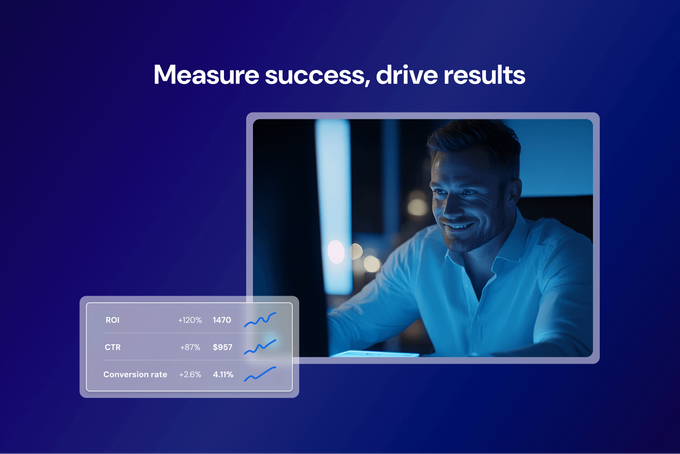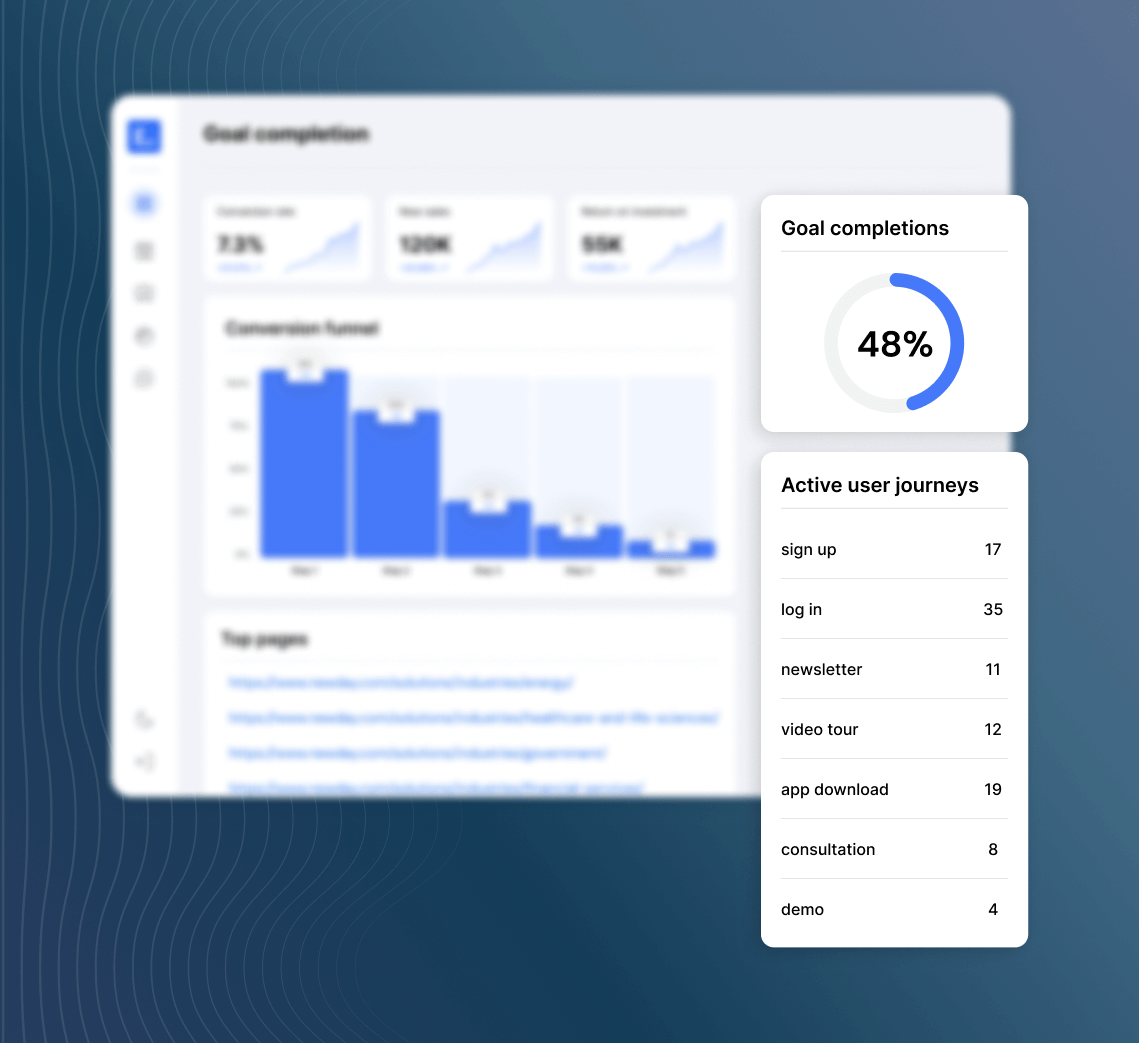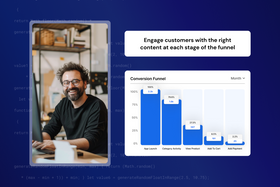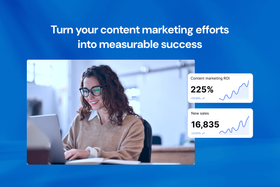18 best content marketing KPIs to track in 2026
Track the right content marketing KPIs to increase brand awareness, boost engagement, and drive conversions.
Updated February 27, 2025

Tracking the right content marketing KPIs can be the difference between guessing and knowing what works. With so many metrics to choose from, it's easy to get overwhelmed or focus on numbers that don't actually drive results or provide actionable insights. In this article, I'll break down the most important content marketing KPIs that help you understand the real impact of your content. Whether your goal is to build brand awareness, foster engagement, or increase conversions, these KPIs will keep you focused on what truly moves the needle.
Key takeaways
- Keep in mind that the goal of content marketing is either to increase brand awareness or conversions.
- With so many content marketing KPIs to measure, focus on the ones that are most significant to your website to avoid getting lost in too much data.
- In general, you should select content marketing KPIs based on the channels you're using.
What is a KPI in content marketing?
Content marketing KPIs are measurable values used to assess the success of your content marketing strategies. They help you determine whether your content is engaging, reaching the right audience, and driving conversions.
Examples of good content marketing KPIs to track include:
- Impressions
- Organic traffic
- Social media engagement (e.g., comments, likes, and shares)
- Conversion rate
- Return on investment (ROI)
Ultimately, the content marketing KPIs you choose to track depend on your needs and goals.
» Find out how to measure content marketing ROI.
Why is it important to track content marketing KPIs?
You need to monitor content marketing KPIs because they provide valuable insights into how well your content is performing at every stage of the user journey. Tracking these KPIs can help you understand what resonates with your audience and how to make data-driven decisions to improve your content strategy.
Other reasons why tracking content marketing KPIs is so important include:
- To learn which channels and types of content marketing are most effective
- To find out whether your content engages your audience and meets their needs
- To optimize based on concrete insights
- To demonstrate and improve content marketing ROI
» Create content that performs—explore our CMS.
How to choose the right content marketing KPIs
The content marketing KPIs you select ultimately depend on the channels you're targeting and the product you're selling. Not every KPI will be relevant, so you need to pick the ones that align with your content strategy.
Start by considering the channels you're focusing on, like social media, SEO, or email. Then, define your primary goals—are you aiming to increase brand awareness, boost engagement, or generate conversions? The type of business you have also matters: whether you're selling fashion, e-commerce products, software, or targeting B2C or B2B audiences will influence which KPIs are most relevant.
» Explore winning content marketing strategies for e-commerce.
Let's look at a few key content marketing KPIs to track if your goals are to increase brand awareness, boost engagement, or generate conversions.
» Talk to an expert to find out which content marketing KPIs you should track.
Content marketing KPIs for increasing brand awareness
Volume and potential reach
When it comes to content marketing, the first metric I'd recommend considering is volume and potential reach. These KPIs measure how many people you could reach across different channels.
In SEO, volume is based on how many people search for the topic you're targeting. Potential reach represents the number of people you could reach through social media, email, or PPC.
» Discover whether you should invest in SEO or PPC.
Impressions
Next, measure impressions—how many people actually saw your content. This is your actual reach, whether on social media, search, paid channels, or email.
It's important to note that impressions differ between search and social media. On social media, an impression typically means someone actually viewed your content, while on search, an impression only indicates that your content appeared in the results; the user may not have clicked to view it. So, impressions on social media are more like clicks in SEO.
» Add social media to your SEO funnel to increase brand awareness.
Relevancy
Another key content marketing KPI is relevancy. It's crucial to reach your audience at the right time and place with the right offering. For example, if you're targeting people interested in buying glasses, you'd want to reach them while they're actively searching or open to engaging with your brand.
Relevancy isn't necessarily a metric, but you should always keep it in mind. Make sure your content is highly relevant to your target audience, the occasion, the platform, and the channel.
» Ensure relevancy with intent-based marketing.
Keyword rankings
Tracking keyword rankings is essential for understanding how your content performs in search engine results. Higher rankings typically drive more traffic and increase the likelihood of conversions.
I would also measure the performance of the keyword clusters you're targeting. You want to ensure you're getting traffic across social media and organic channels for the main topics you focus on. For example, if you want to be an authority on SEO ROI, you should be ranking for multiple posts related to SEO ROI, not just one. This shows how well you're performing for each topic as a whole.
Number of keywords your content ranks for
Another important (but often overlooked) content marketing KPI is the number of keywords your content ranks for. The more keywords you rank for, the more likely it is that Google sees your content as valuable. It also means your content targets more search intents and that there's potential to get even more traffic.
» Get content strategy software that identifies relevant keywords and maps your content according to search intent.
Branded searches
Look out for an increase in branded searches from your content, especially on social media. This is important because platforms like Instagram, TikTok, and YouTube often involve "zero-click" content, where users engage without clicking through, as there's limited opportunity to do so (e.g., only a link in bio on TikTok).
You can also measure branded product searches. For example, Nike might track searches like "Nike running shoes" to see if people are searching for specific products.
An increase in branded searches indicates that your content is successful and people are actively searching for your brand or products. Tracking branded searches helps measure the direct impact of your content on brand awareness.
Content marketing KPIs for improving engagement
Organic traffic
Organic traffic tells you how many people find your content through search engines. Getting more organic traffic usually means your content aligns well with search intent and attracts users who are genuinely interested in your content.
Monitoring this metric helps you understand which pieces drive the most interest and keeps you focused on creating content that converts while resonating with your audience.
» Increase traffic and conversions with Entail.
Click-through rate (CTR)
Click-through rate (CTR) measures how often people click on your content or the elements within your content, such as internal links, call-to-action buttons, or popups. This is crucial for assessing engagement.
You should offer multiple click opportunities within the content, but not all of them should lead directly to bottom-of-the-funnel actions like "Book a Demo" or "Sign Up." Instead, include links that guide users to the next step in their journey without being salesy.
» Increase CTR on your content pages to over 40% with Entail CRO.
Email open rate
Email open rate is a critical KPI for gauging how well your content catches your subscribers' interest and keeps them engaged. Monitoring open rates helps you identify which topics, formats, or send times drive engagement, which allows you to refine your email strategy.
Bounce rate
Bounce rate measures the percentage of users who visit a page on your site and leave without interacting with the content. A high bounce rate can indicate that your content isn't meeting users' needs. By monitoring bounce rate, you can identify pages that need optimization—whether by improving relevance or offering clearer calls to action.
That said, I would say it's more useful to monitor clicks on the elements on the page. The goal isn't to keep the user on the page for a long time; it's to help them move to the next step in their journey.
» Optimize the user journey to decrease bounce rate.
Pages per session
Pages per session tracks the average number of pages a user visits on your site in one session. This KPI is crucial for evaluating how well your content encourages users to explore your site more deeply. High pages per session suggest that users find your content relevant and valuable.
Backlinks, shares, and mentions
Backlinks, shares, and mentions show how many people appreciate your content. These KPIs reflect the quality, relevance, and value of your content. When people cite or refer to your content, it shows you're creating great content, building authority, strengthening your brand, and getting more exposure.
Social media interactions
If social media is one of the channels you target, you can measure engagement by looking at follower growth, comments, and likes. Follower growth indicates expanding reach, while comments and likes tell you how often users interact with your content. Tracking these metrics can help you build stronger connections with your audience, making them more likely to convert and become brand advocates.
Content marketing KPIs for driving conversions
Conversions
Eventually, you want to measure conversions. When doing so, break them down into five types, representing different touchpoints in the user journey:
- Single touch: A user sees your content, which showcases your product, and immediately buys it.
- First touch: A user encounters your content, continues their journey, and later purchases the product.
- Last touch: A user comes through a different channel, then makes a purchase or converts on your content page.
- Assist: A user arrives from a different channel, engages with your content, and buys the product later down the line.
- Multi-touch: A user interacts with your content at multiple stages before converting, involving any combination of the above touchpoints.
Multi-touch is especially relevant in content marketing, where it usually takes a few touchpoints to convert the user. Tools like Entail CRO can help optimize for multi-touch conversions and accurately attribute value across the entire user journey.
» Track and optimize the user journey with multi-touch attribution.
Conversion rate
Conversion rate measures the percentage of visitors who complete a desired action, such as making a purchase, signing up for a newsletter, or downloading a guide. A high conversion rate indicates that your content resonates with your target audience and effectively drives them to take action.
» Find out which conversion metrics you should be tracking.
Customer acquisition cost (CAC)
If you want to improve conversions and optimize your budget, you should be tracking customer acquisition cost (CAC). CAC measures the total cost of acquiring a new customer, including expenses like content creation, advertising, and SEO. A lower CAC indicates a more cost-effective customer acquisition process, allowing for higher ROI and more sustainable growth.
Customer lifetime value (CLV)
Customer lifetime value (CLV) estimates the total revenue you can reasonably expect from a single customer over their lifetime. Understanding CLV can help you direct your content marketing efforts toward nurturing existing customers, encouraging repeat purchases, and upselling or cross-selling additional products.
Return on investment (ROI)
Return on investment (ROI) is one of the most important content marketing KPIs to monitor. It measures the financial return generated from your content marketing investment. By calculating ROI, you can justify your budget, demonstrate the effectiveness of your campaigns, and make data-driven optimizations. A high ROI indicates that content marketing is a worthwhile investment for your business.
Maximize your content's impact
At the end of the day, the KPIs you track should help you understand how well your content connects with your audience and supports your goals. By focusing on metrics like CTR, reach, and conversions, you can see exactly where your content is working and where it needs adjusting. That way, you're equipped to make smarter decisions and drive meaningful results from your content.
» See which SEO KPIs you should be tracking in 2026.





